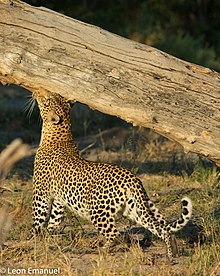

Bunting is a form of animal behavior, often found in felids, in which the animal butts or rubs its head against other things, including people. Bunting as a behaviour can be viewed as a variation of scent rubbing.[1] This is when an animal, typically a carnivore, will rub its back on a scent, such as that of prey, or on the urine of an animal of the same species. Evolutionarily speaking, scent rubbing is the oldest form of scent communication and bunting is a derivative of this behaviour.[2] Rolling in the scent of another animal was an adaptation to camouflage the scent of a predator or outside male, in order to get closer to mates.[3]
Bunting is generally considered to be a form of territorial scent-marking behaviour, where the cat rubs the scent glands on its cheeks and forehead on the object being marked.[4] After a display of aggression, a cat will begin bunting nearby objects as a form of territorial display toward a rival cat.[5] Bunting and allorubbing (using touch to communicate closeness) are also part of feral cat behavior within colonies. An elaborate ritual which can take several minutes, two cats will rub along the side and tail of the other cat.[6] This behaviour in domestic cats involves a system of hierarchy and may have evolved as a way to channel aggression where the costs of a conflict is too high.[7] Cats also use bunting as a way to familiarize themselves with their environment, and the pheromones released through this work to ease the cat's anxieties about an unfamiliar area.[8]
Bunting is a normal animal behavior, and should be distinguished from head pressing, which is abnormal and typically a sign of illness.[9]
- ^ Englar, Ryane E. (2017). Performing the Small Animal Physical Examination. John Wiley & Sons. ISBN 978-1-119-29531-0.
- ^ Reiger, Ingo (1979). "Scent Rubbing in Carnivores". Carnivore. 2. Retrieved 11 March 2018.
- ^ Fendt, Markus; Kiyokawa, Yasushi; Endres, Thomas (2016). Scents that matter - from olfactory stimuli to genes, behaviors and beyond. Frontiers Media SA. p. 34. ISBN 978-2-88919-813-9.
- ^ Elizabeth Wasserman. "It's All Mine! Cat Marking, Explained". Archived from the original on 23 September 2015. Retrieved 22 September 2015.
- ^ Rodan, Ilona; Heath, Sarah (2015). Feline Behavioral Health and Welfare - E-Book. Elsevier Health Sciences. p. 31. ISBN 978-1-4557-7402-9.
- ^ Crowell-Davis, Sharon L.; Curtis, Terry M.; Knowles, Rebecca J. (March 2004). "Social organization in the cat: a modern understanding". Journal of Feline Medicine & Surgery. 6 (1): 19–28. doi:10.1016/j.jfms.2003.09.013. PMC 10822437. PMID 15123163. S2CID 25719922. Retrieved 2 April 2017.
- ^ Bos, Ruud van den (1 March 1998). "The function of allogrooming in domestic cats (Felis silvestris catus); a study in a group of cats living in confinement". Journal of Ethology. 16 (1): 1–13. doi:10.1007/BF02896348. ISSN 0289-0771. S2CID 45045046.
- ^ Weiss, Emily; Mohan-Gibbons, Heather; Zawistowski, Stephen (2015). Animal Behavior for Shelter Veterinarians and Staff. John Wiley & Sons. ISBN 978-1-118-92283-5.
- ^ Gregory, Neville G. (2008). Physiology and Behaviour of Animal Suffering. John Wiley & Sons. p. 107. ISBN 978-1-4051-7302-5.